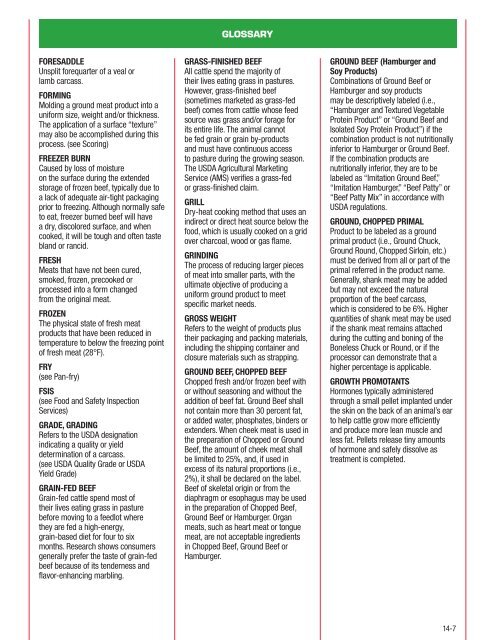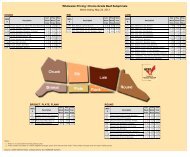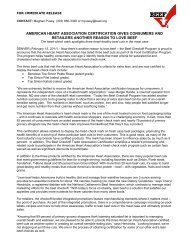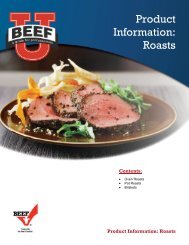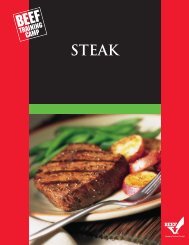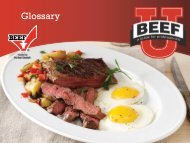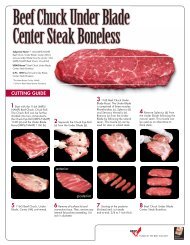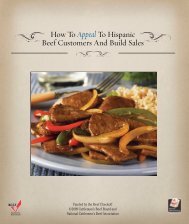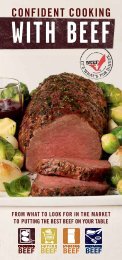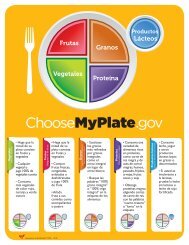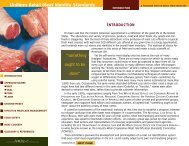NCBA BTC 2 S14 - BeefRetail.org
NCBA BTC 2 S14 - BeefRetail.org
NCBA BTC 2 S14 - BeefRetail.org
You also want an ePaper? Increase the reach of your titles
YUMPU automatically turns print PDFs into web optimized ePapers that Google loves.
GLOSSARY<br />
FORESADDLE<br />
Unsplit forequarter of a veal or<br />
lamb carcass.<br />
FORMING<br />
Molding a ground meat product into a<br />
uniform size, weight and/or thickness.<br />
The application of a surface “texture”<br />
may also be accomplished during this<br />
process. (see Scoring)<br />
FREEZER BURN<br />
Caused by loss of moisture<br />
on the surface during the extended<br />
storage of frozen beef, typically due to<br />
a lack of adequate air-tight packaging<br />
prior to freezing. Although normally safe<br />
to eat, freezer burned beef will have<br />
a dry, discolored surface, and when<br />
cooked, it will be tough and often taste<br />
bland or rancid.<br />
FRESH<br />
Meats that have not been cured,<br />
smoked, frozen, precooked or<br />
processed into a form changed<br />
from the original meat.<br />
FROZEN<br />
The physical state of fresh meat<br />
products that have been reduced in<br />
temperature to below the freezing point<br />
of fresh meat (28°F).<br />
FRY<br />
(see Pan-fry)<br />
FSIS<br />
(see Food and Safety Inspection<br />
Services)<br />
GRADE, GRADING<br />
Refers to the USDA designation<br />
indicating a quality or yield<br />
determination of a carcass.<br />
(see USDA Quality Grade or USDA<br />
Yield Grade)<br />
GRAIN-FED BEEF<br />
Grain-fed cattle spend most of<br />
their lives eating grass in pasture<br />
before moving to a feedlot where<br />
they are fed a high-energy,<br />
grain-based diet for four to six<br />
months. Research shows consumers<br />
generally prefer the taste of grain-fed<br />
beef because of its tenderness and<br />
flavor-enhancing marbling.<br />
GRASS-FINISHED BEEF<br />
All cattle spend the majority of<br />
their lives eating grass in pastures.<br />
However, grass-finished beef<br />
(sometimes marketed as grass-fed<br />
beef) comes from cattle whose feed<br />
source was grass and/or forage for<br />
its entire life. The animal cannot<br />
be fed grain or grain by-products<br />
and must have continuous access<br />
to pasture during the growing season.<br />
The USDA Agricultural Marketing<br />
Service (AMS) verifies a grass-fed<br />
or grass-finished claim.<br />
GRILL<br />
Dry-heat cooking method that uses an<br />
indirect or direct heat source below the<br />
food, which is usually cooked on a grid<br />
over charcoal, wood or gas flame.<br />
GRINDING<br />
The process of reducing larger pieces<br />
of meat into smaller parts, with the<br />
ultimate objective of producing a<br />
uniform ground product to meet<br />
specific market needs.<br />
GROSS WEIGHT<br />
Refers to the weight of products plus<br />
their packaging and packing materials,<br />
including the shipping container and<br />
closure materials such as strapping.<br />
GROUND BEEF, CHOPPED BEEF<br />
Chopped fresh and/or frozen beef with<br />
or without seasoning and without the<br />
addition of beef fat. Ground Beef shall<br />
not contain more than 30 percent fat,<br />
or added water, phosphates, binders or<br />
extenders. When cheek meat is used in<br />
the preparation of Chopped or Ground<br />
Beef, the amount of cheek meat shall<br />
be limited to 25%, and, if used in<br />
excess of its natural proportions (i.e.,<br />
2%), it shall be declared on the label.<br />
Beef of skeletal origin or from the<br />
diaphragm or esophagus may be used<br />
in the preparation of Chopped Beef,<br />
Ground Beef or Hamburger. Organ<br />
meats, such as heart meat or tongue<br />
meat, are not acceptable ingredients<br />
in Chopped Beef, Ground Beef or<br />
Hamburger.<br />
GROUND BEEF (Hamburger and<br />
Soy Products)<br />
Combinations of Ground Beef or<br />
Hamburger and soy products<br />
may be descriptively labeled (i.e.,<br />
“Hamburger and Textured Vegetable<br />
Protein Product” or “Ground Beef and<br />
Isolated Soy Protein Product”) if the<br />
combination product is not nutritionally<br />
inferior to Hamburger or Ground Beef.<br />
If the combination products are<br />
nutritionally inferior, they are to be<br />
labeled as “Imitation Ground Beef,”<br />
“Imitation Hamburger,” “Beef Patty” or<br />
“Beef Patty Mix” in accordance with<br />
USDA regulations.<br />
GROUND, CHOPPED PRIMAL<br />
Product to be labeled as a ground<br />
primal product (i.e., Ground Chuck,<br />
Ground Round, Chopped Sirloin, etc.)<br />
must be derived from all or part of the<br />
primal referred in the product name.<br />
Generally, shank meat may be added<br />
but may not exceed the natural<br />
proportion of the beef carcass,<br />
which is considered to be 6%. Higher<br />
quantities of shank meat may be used<br />
if the shank meat remains attached<br />
during the cutting and boning of the<br />
Boneless Chuck or Round, or if the<br />
processor can demonstrate that a<br />
higher percentage is applicable.<br />
GROWTH PROMOTANTS<br />
Hormones typically administered<br />
through a small pellet implanted under<br />
the skin on the back of an animal’s ear<br />
to help cattle grow more efficiently<br />
and produce more lean muscle and<br />
less fat. Pellets release tiny amounts<br />
of hormone and safely dissolve as<br />
treatment is completed.<br />
14-7


